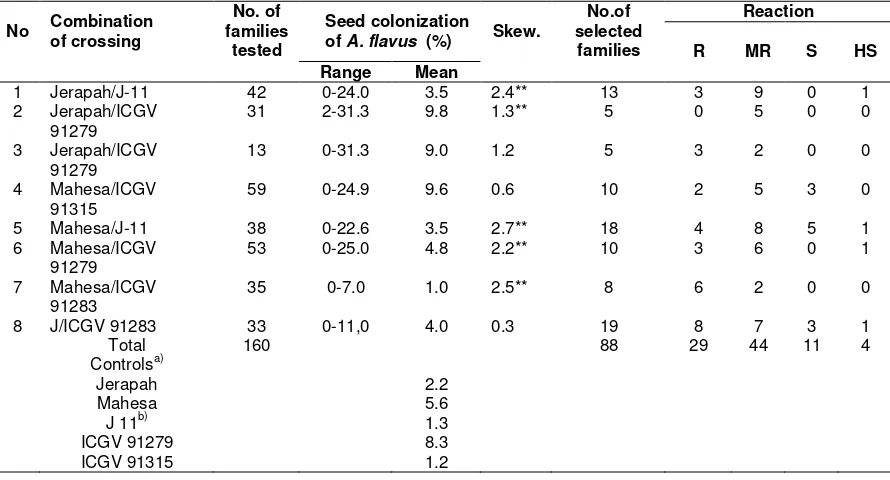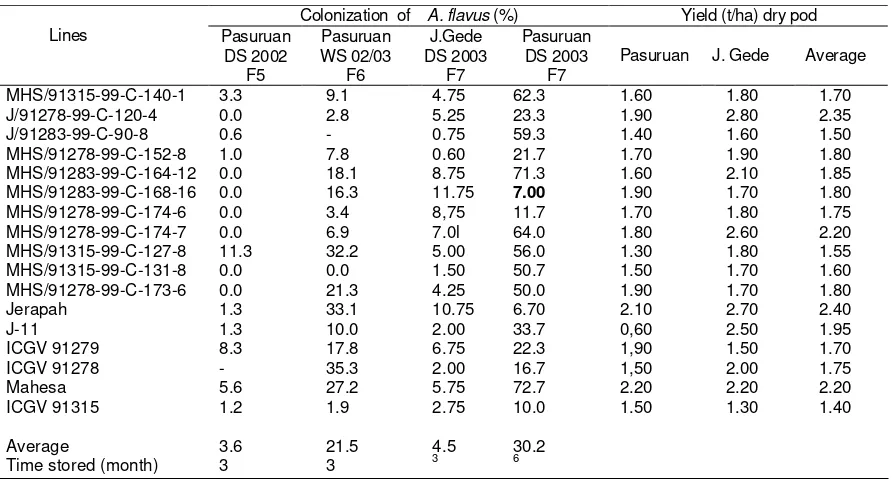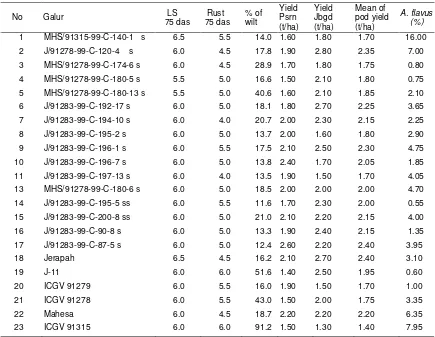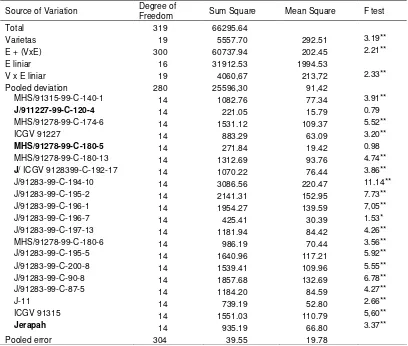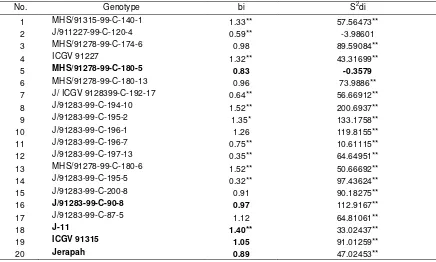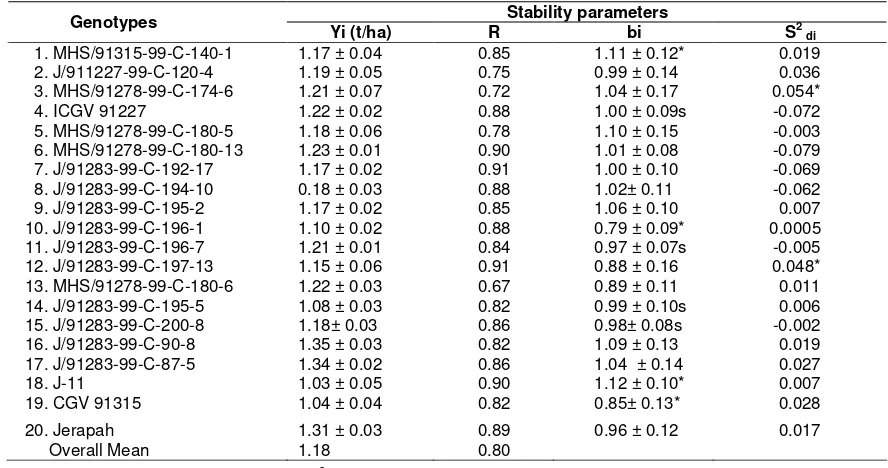SEED COAT RESISTANCE OF GROUDNUT TO
Aspergillus flavus
AND THEIR STABILITY PERFORMANCE IN THE FIELD
Astanto Kasno*), Trustinah, J. Purnomo and Sumartini Indonesian Legume and Tuber Crops Research Institute Jl. Raya Kendalpayak km 8 P.O. Box. 66 Malang 65101 *)
Corresponding author Phone :+62-341-801468 E-mail: [email protected]
Received: August 8,2010/ Accepted: December 24,2010
ABSTRACT
One of the weaknesses of the groundnut is the easiness to be infected by fungi, especially Aspergillus flavus that produces aflatoxin. Seed from the field experiments for all step of selection (F5 until to multilocation yield test) after processed then stored for 3 and 6 months, further tested their respons to A. flavususing a standard method. Examined for seed coat resistance to colonization of A. flavus were carried out in laboratory ILETRI (Indonesian of Legume and Tuber Crops Research Institute) since years of 2002 to 2006. Stability performance of resistance to A. flavus was analyzed with regression technique. Per-formance of resistance to A. flavus of selected lines tested were not consistant among 16 of testing envoronments. Among genotypes were also sigficantly different response to A. flavus invasion from location to location, indicated that those performance of some lines were not stable, except line of MHS/91278-99-C-180-5. The highest pod yield was occupied by line of J/91283-99-C-90-8 and stable, however it’s resistance to A. flavus did not stable. The resistance of J/91283-99-C-90-8 to A. flavus antil to three months after after seed strored similar with variety of J-11.
Keywords: groundnut, Aspergillus flavus, aflatoxin
INTRODUCTION
Groundnut as healthy food, in the reality have weakness so that its benefit become less optimal otherwise handled well. One of the weakness of groundnut is easy to infected by toxigenic fungi, especially Aspergillus flavus who produce aflatoxin. Aflatoxin was a carcinogenic substances in foods and in animal
feeds. Groundnut meal contaminated with aflatoxin could developed liver cancer (Swindle, 1994).
Studies revelead that the test groundnut crop was infected by aflatoxin producing fungi while it still in the field. Thus the source of aflatoxin contamination may be in the field. Mixon and Rogers (1975) first suggested that use of groundnut varieties resistant to seed invasion and colonization by A. flavus could be an affective means of preventing aflatoxin contamination. The existence of seed coat resistance was a logical assumption, considering that seeds with damage testa more easily and rapidly invaded by fungus than that were seeds with intact testa, and colored testa conferred greater resistance to invasion by A. flavus than white or variegated testa (Carter 1973 in Mehan, 1994). The mean seed colonization levels in the resistant genotype by A. flavus tested overall several years ranged from 8-13% (Mixon 1986 in Mehan 1994). Sanders et al. (1993) reported that high A. flavus invasion percentages may be found without the presence of aflatoxin, suggesting that invasion and subsequent growth and aflatoxin contamination in groundnut may be separate process or at least regulated in different ways. Furher, invasion and aflatoxin contamination groundnut grown under drought conditions usually occur first and to a greater degree in small, immature pods. At least two kinds on resistance have been discovered in groundnut, ie. resistance to A. flavus invasion and resistance to aflatoxin production even though invasion occur (Rao et al., 1994). Cotty (1988 in Daren, 1992 ), and Daren (1992) sugesting used TF (Tube Fluorescence) methods for large-scale screening of groundnut genotypes for resistance to aflatoxin production due to a simple, rapid and inexpensive. Waliyar
et al. (1994) found the positive correlation between resistance in field and resistance in laboratory inoculation test and suggested that either methods could be used in evaluating groundnut cultivars or breeding lines for seed coat resistance to A. flavus infection by genotypes 15% or fewer seeds colonization were regarded as resistant.
This paper describes some studied of evaluating groundnut lines of F5-F8 derivated from population of crossed between seed coat resistance parents to A. flavus wich were introduced from ICRISAT in 1998 (J 11, ICGV 91278, ICGV 91279, ICGV 91283, ICGV 91284 and ICGV 91315) with Mahesa and Jerapah varieties, and their performance their stabilitilty performance in the field of yied and seed coat resistace to. A. flavus.
Groundnut varieties of Mahesa and Jerapah were commercial variety of excelent agronomic characters, moderately tolerant to leaf diseases and tolerant to drought stressed at reproductive phase, respectively.
MATERIALS AND METHODS
Line selection for seed coat resistance to colonization byA. flavus in laboratory come from groundnut population of F5 derivated from crossing combination of two commercial parents (Jerapah and Mahesa) varieties with five genotypes as donors for seed-coat resistance (J11, ICGV 91278, ICGV 91279, ICGV 91283, ICGV 91284 and ICGV 91315) in 1999. Variety of J 11 was used extensively as gene donors for seed-coat resistance, and their stability of their resistance to seed colonization by A. flavus. J11 and other genotypes were introduced from ICRISAT in 1988. Hybridization and lines development were done in Malang, Jambegede and Pasuruan from years of 2002-2003. Selected lines were tested of their performance for yield and seed coat resistance to A. flavus at various sites (East Java: Pasuruan, Lamongan, Lumajang, Blitar; Central Java: Wonogiri, Blora, Tayu, Pati; Yogyakarta: Sleman, Bantul, and Lampung: Punggur, Central Lampung) from years of 2004 to 2006 (Table 7).
Culture practice in the field for various generation or researches were : optimal of soil tillage, groundnut seed grown at plant spacing 40 cm x 10 cm, 1 seed/hole, basal fertilization with 50 kg of Urea, 100 kg of Super phosphate,
and 100 kg of KCl per hectare, respectively; two times weeding at 14 dan 21 days after sowing (DAS), leaf diseases controll at 7, 9 weeks after sowing (WAS), and harvesting at optimum maturity (95-105) DAS.
After groundnut harvested for all of the breeding steps then pods were handpicked in the field and as soon as possible naturally dried by the sun. After drying, the dried pods were stored in well-ventilated room for 3-6 months with protection from insects. From the stored, intact seeds of each lines 25 seeds samples were taken, placed in clean beaker and covered with a 0.5% aqueous solution of sodium hypochlorite. Seed were soaked for 3 minutes, the exess solution drained of, and seeds rinsed in two changes of sterile distilled water. The water was then drained off and the seeds hydrated to about 20% moisture containt by soaking them for 10-15 minutes in sterile distilled water. Seeds placed in a sterile in semi rigid plastick boxes then inoculated with 1 mL of spore suspension of the toxigenic A. flavus isolate of Pasuruan (approximately 4 x 106 conidia m L-1). The spore suspension was prepared from 8-10 days-old culture. Plastick boxes were then placed in a AC room with temperature at 25o C. After 8 days, the seeds were visually examed for invasion and colonization by A. flavus by recording. All the activities were carried out in the laboratory of ILETRI (Indonesian of legume and Tuber crops Research Institute) since years of 2002 to 2006.
The percentage of seeds invaded and colonized as shown by the presence of sporulating surface growth were calculated using method as suggested by Mehan (1989 in Mehan, 1994) seed sporulating (0%,) half seed sporulated (50%), seed fully sporulated (100%).
RESULTS AND DISCUSSION
Lines Selection to A. flavusResistance in the
Laborarory
Line selection of groundnut for seed coat resistance was started at F5 generations, there were selected a number of families, namely 88 families of eight crosses combination (Table 1).
Value of skewness were positive for all of cross combinations, its mean that population had a right skewed distribution, showing mode<median<mean for seed colonization of A. flavus. So, mostly line were susceptible (Wannacott and Wannacott, 1972). 0f these selected families produced 140 lines and tested for their yield in preliminary yield test. There
were selected 80 lines which have seed coat resistace to A. flavus and selected for advanced yield test. Total of 17 lines were selected for main diseases and excelent agronomic-characters and yield using variety Jerapah as the check.
Groundnut genotypes tend to loss their resistance to A. flavus after six months storaged included J11, exception for lines of MHS/91283-99-C-168-16, ICGV 91278, ICGV 9315 and Jerapah. The promissing line of J/91283-99-C-90-8 showed resistance to A. flavus until three months storaged, as well as the control variety of J11 (Table 2). These line were tested for their yield stability and resistance to A. flavus across environments (Table 3).
Table 1. A. flavus seed colonization (%) of F5 families. Laroratory of ILETRI (Indonesian of legume and Tuber crops Research Institute) Malang, 2002
Reaction
No Combination
of crossing
No. of families
tested
Seed colonization
of A. flavus (%) Skew.
No.of selected
families
Range Mean
R MR S HS
1 Jerapah/J-11 42 0-24.0 3.5 2.4** 13 3 9 0 1 2 Jerapah/ICGV
91279
31 2-31.3 9.8 1.3** 5 0 5 0 0
3 Jerapah/ICGV 91279
13 0-31.3 9.0 1.2 5 3 2 0 0
4 Mahesa/ICGV 91315
59 0-24.9 9.6 0.6 10 2 5 3 0
5 Mahesa/J-11 38 0-22.6 3.5 2.7** 18 4 8 5 1 6 Mahesa/ICGV
91279
53 0-25.0 4.8 2.2** 10 3 6 0 1
7 Mahesa/ICGV 91283
35 0-7.0 1.0 2.5** 8 6 2 0 0
8 J/ICGV 91283 33 0-11,0 4.0 0.3 19 8 7 3 1
Total 160 88 29 44 11 4
Controlsa)
Jerapah 2.2
Mahesa 5.6
J 11b) 1.3
ICGV 91279 8.3
ICGV 91315 1.2
Table 2. Colonization of A. flavus of some lines of groundnut selected from F5–F7 followed with pod
Stability Performance of Colonozation to A.
flavus in the Field
Total of 20 genotypes od groundnut were tested at 16 locations for their stability performance to A. flavus and yield in the field. The combined variance analyses of seed colonization of A. flavus showed that among lines were different significantly, and Vx E (linear) interaction was also significant indicated that among lines have different coefficient of regression. Deviation from regression mainly were significant, except for J/911227-99-C-120-4 and MHS/91278-99-C-180-5 (Table J/911227-99-C-120-4). Lines of 180-5, MHS/91278-99-C-180-13, J/91283-99-C-196-1, J/91283-99-C-200-8, J/91283-99-C-90-8, J/91283-99-C-87-5, ICGV 91315 and Jerapah have coefficient of regression (bi) were similar with unity, but not stable because deviation from regression were different significant than zero, in exception of location/environment from the overall mean of colonization).
Table 3. Selected lines of F8 who resistant to rust, leaf spot, wild diseases and A. flavus followed by pod yield. Pasuruan (Psrn) and Jambegede (Jbgd), growing season of 2003-2004*)
No Galur LS
75 das
Rust 75 das
% of wilt
Yield Psrn (t/ha)
Yield Jbgd (t/ha)
Mean of pod yield (t/ha)
A. flavus (%) 1 MHS/91315-99-C-140-1 s 6.5 5.5 14.0 1.60 1.80 1.70 16.00 2 J/91278-99-C-120-4 s 6.0 4.5 17.8 1.90 2.80 2.35 7.00 3 MHS/91278-99-C-174-6 s 6.0 4.5 28.9 1.70 1.80 1.75 0.80 4 MHS/91278-99-C-180-5 s 5.5 5.0 16.6 1.50 2.10 1.80 0.75 5 MHS/91278-99-C-180-13 s 5.5 5.0 40.6 1.60 2.10 1.85 2.10 6 J/91283-99-C-192-17 s 6.0 5.0 18.1 1.80 2.70 2.25 3.65 7 J/91283-99-C-194-10 s 6.0 4.0 20.7 2.00 2.30 2.15 2.25 8 J/91283-99-C-195-2 s 6.0 5.0 13.7 2.00 1.60 1.80 2.90 9 J/91283-99-C-196-1 s 6.0 5.5 17.5 2.10 2.50 2.30 4.75 10 J/91283-99-C-196-7 s 6.0 5.0 13.8 2.40 1.70 2.05 1.85 11 J/91283-99-C-197-13 s 6.0 4.0 13.5 1.90 1.50 1.70 4.05 13 MHS/91278-99-C-180-6 s 6.0 5.0 18.5 2.00 2.00 2.00 4.70 14 J/91283-99-C-195-5 ss 6.0 5.5 11.6 1.70 2.30 2.00 0.55 15 J/91283-99-C-200-8 ss 6.0 5.0 21.0 2.10 2.20 2.15 4.00 16 J/91283-99-C-90-8 s 6.0 5.0 13.3 1.90 2.40 2.15 1.35 17 J/91283-99-C-87-5 s 6.0 5.0 12.4 2.60 2.20 2.40 3.95 18 Jerapah 6.5 4.5 16.2 2.10 2.70 2.40 3.10
19 J-11 6.0 6.0 51.6 1.40 2.50 1.95 0.60
20 ICGV 91279 6.0 5.5 16.0 1.90 1.50 1.70 1.00 21 ICGV 91278 6.0 5.5 43.0 1.50 2.00 1.75 3.35 22 Mahesa 6.0 4.5 18.7 2.20 2.20 2.20 6.35 23 ICGV 91315 6.0 6.0 91.2 1.50 1.30 1.40 7.95
Remarks = *) Jbgd= Jambegede; Psrn = Pasuruan s = selected; LS = leaf spot; das = days after sowing
The regression coefficient for pod yield plotted against environmental index (the deviation of the mean of all the varieties at a given location/environment from the overall mean) indicated that some breeding lines were also responsive to the environment (Table 6). Genotypes used as parents in this breeding were reported as seed coat resistance. The genotype, mainly J-11 have been used extensively as gene donors for seed-coat resistance (Rao et. al., 1994). Breeding lines were tested in multilocational trials to evaluate the stability of their resistance. Identification of stable resistance because past finding have indicated that environment factors could
Table 4. Analisis of varianceof stability for seed colonization by A. flavus
Source of Variation Degree of
Freedom Sum Square Mean Square F test
Total 319 66295.64
Varietas 19 5557.70 292.51 3.19**
E + (VxE) 300 60737.94 202.45 2.21**
E liniar 16 31912.53 1994.53
V x E liniar 19 4060,67 213,72 2.33**
Pooled deviation 280 25596,30 91,42
MHS/91315-99-C-140-1 14 1082.76 77.34 3.91**
J/911227-99-C-120-4 14 221.05 15.79 0.79
MHS/91278-99-C-174-6 14 1531.12 109.37 5.52**
ICGV 91227 14 883.29 63.09 3.20**
MHS/91278-99-C-180-5 14 271.84 19.42 0.98
MHS/91278-99-C-180-13 14 1312.69 93.76 4.74**
J/ ICGV 9128399-C-192-17 14 1070.22 76.44 3.86** J/91283-99-C-194-10 14 3086.56 220.47 11.14** J/91283-99-C-195-2 14 2141.31 152.95 7.73** J/91283-99-C-196-1 14 1954.27 139.59 7,05** J/91283-99-C-196-7 14 425.41 30.39 1.53* J/91283-99-C-197-13 14 1181.94 84.42 4.26** MHS/91278-99-C-180-6 14 986.19 70.44 3.56** J/91283-99-C-195-5 14 1640.96 117.21 5.92** J/91283-99-C-200-8 14 1539.41 109.96 5.55** J/91283-99-C-90-8 14 1857.68 132.69 6.78** J/91283-99-C-87-5 14 1184.20 84.59 4.27**
J-11 14 739.19 52.80 2.66**
ICGV 91315 14 1551.03 110.79 5,60**
Jerapah 14 935.19 66.80 3.37**
Pooled error 304 39.55 19.78
The importance of the stability of seed coat resistance has been stressed by many previous workers. Rao et. al. (1994) reported that the regression coefficient (bi) for resistance plotted against the mean pecentage seed colonization indicated that the selected resistant breeding lines were stable as the resistant source lines and had similar levels of seed colonization to the resistance source lines. Drought stress was one the environment factor who affect significantly on seed colonization by A. flavus. The association of high aflatoxin contamination and drought stress was reported by previous researchers.
Extensive studies have been conducted to define the environmental condition associated with pre harvest and aflatoxin contamination on groundnut. Cole et al. (1994), indicated that
when mean soil temperatures were in the optimum range (28-30.5o C) (Sanders et al., 1993). Wilson and Stansell (1983), reported that in 2 of 4 years found significantly more aflatoxin in groundnuts when stress was imposed at least 40 days immediately preceeding harvest. There were relationship between water stresses and soil temperatures to A.flavus invasion and aflatoxin production.(Sanders et. al., 1993).
Water stress during the last 40 to 75 days of the season contributed to aflatoxin contamination of sound mature kernels three of the four years on one and on both cultivars. Because of years to years variation, drought
stress alone does not consistently effect field aflatoxin contamination. In some years other environmental factors must have interacted with drought stress to promote on inhibite preharvest aflatoxin contamination. In all treatments where irrigation was applied during the last 40 days of the season, no significant aflatoxin contami-nation was detected in any cultivar any years of the test (Wilson and Stansell, 1983). Pettit et al. (1989 in Pettit et al., 1994) demonstrated that groundnuts grown under dry land conditions, where drought stress occurred, contained more aflatoxin before digging that groundnuts under irrigation.
Table 5. Stability analyses for seed colonization of A.flavus
No. Genotype bi S2di
1 MHS/91315-99-C-140-1 1.33** 57.56473** 2 J/911227-99-C-120-4 0.59** -3.98601 3 MHS/91278-99-C-174-6 0.98 89.59084**
4 ICGV 91227 1.32** 43.31699**
5 MHS/91278-99-C-180-5 0.83 -0.3579
6 MHS/91278-99-C-180-13 0.96 73.9886** 7 J/ ICGV 9128399-C-192-17 0.64** 56.66912** 8 J/91283-99-C-194-10 1.52** 200.6937** 9 J/91283-99-C-195-2 1.35* 133.1758**
10 J/91283-99-C-196-1 1.26 119.8155**
11 J/91283-99-C-196-7 0.75** 10.61115** 12 J/91283-99-C-197-13 0.35** 64.64951** 13 MHS/91278-99-C-180-6 1.52** 50.66692** 14 J/91283-99-C-195-5 0.32** 97.43624**
15 J/91283-99-C-200-8 0.91 90.18275**
16 J/91283-99-C-90-8 0.97 112.9167**
17 J/91283-99-C-87-5 1.12 64.81061**
18 J-11 1.40** 33.02437**
19 ICGV 91315 1.05 91.01259**
20 Jerapah 0.89 47.02453**
Remarks= **) Signicant than unity and zero, respectivelly for bi and S2di = (ó2-bI Y ij I j ) S2di (negative, meaning
Tabel 6. Stability parameters of pod yield of groundnut at 16 locations in years of 2004-2006*) Stability parameters
Genotypes
Yi (t/ha) R bi S2 di
1. MHS/91315-99-C-140-1 1.17 ± 0.04 0.85 1.11 ± 0.12* 0.019 2. J/911227-99-C-120-4 1.19 ± 0.05 0.75 0.99 ± 0.14 0.036 3. MHS/91278-99-C-174-6 1.21 ± 0.07 0.72 1.04 ± 0.17 0.054* 4. ICGV 91227 1.22 ± 0.02 0.88 1.00 ± 0.09s -0.072 5. MHS/91278-99-C-180-5 1.18 ± 0.06 0.78 1.10 ± 0.15 -0.003 6. MHS/91278-99-C-180-13 1.23 ± 0.01 0.90 1.01 ± 0.08 -0.079 7. J/91283-99-C-192-17 1.17 ± 0.02 0.91 1.00 ± 0.10 -0.069 8. J/91283-99-C-194-10 0.18 ± 0.03 0.88 1.02± 0.11 -0.062 9. J/91283-99-C-195-2 1.17 ± 0.02 0.85 1.06 ± 0.10 0.007 10. J/91283-99-C-196-1 1.10 ± 0.02 0.88 0.79 ± 0.09* 0.0005 11. J/91283-99-C-196-7 1.21 ± 0.01 0.84 0.97 ± 0.07s -0.005 12. J/91283-99-C-197-13 1.15 ± 0.06 0.91 0.88 ± 0.16 0.048* 13. MHS/91278-99-C-180-6 1.22 ± 0.03 0.67 0.89 ± 0.11 0.011 14. J/91283-99-C-195-5 1.08 ± 0.03 0.82 0.99 ± 0.10s 0.006 15. J/91283-99-C-200-8 1.18± 0.03 0.86 0.98± 0.08s -0.002 16. J/91283-99-C-90-8 1.35 ± 0.03 0.82 1.09 ± 0.13 0.019 17. J/91283-99-C-87-5 1.34 ± 0.02 0.86 1.04 ± 0.14 0.027 18. J-11 1.03 ± 0.05 0.90 1.12 ± 0.10* 0.007 19. CGV 91315 1.04 ± 0.04 0.82 0.85± 0.13* 0.028 20. Jerapah 1.31 ± 0.03 0.89 0.96 ± 0.12 0.017
Overall Mean 1.18 0.80 Remarks= *) bi different from unity : S2 di = different from 0
Table 7. Description of location for yield and tolrence performance to A. flavus testing of groundnut in 2004-2006
No Locations Elevation Soil type/ climate
Growing
season Problems 1 Pasuruan,
East Java
LLE Alfisol/D3 WS 04 Weed
2 Wonogiri, Central Java LLE Entisol/D3 WS 04 Flooded at harvesting time 3 Lamongan,
East Java
LLE Alfisol/D3 DS, 04 Drought and leaf diseases
4 Blora, Central Java LLE Alfisol/D3 WS, 04/05 Flooded at harvesting time 5 Tuban, East Java LLE Alfisol/D3 DS, 04 Nutrients disorder 6 Lumajang, East Java LLE Alfisol/D3 WS’ 04 Viruse
7 Tayu, Pati, Jateng LLE Alfisol/D3 WS’04 Flooded at harvesting time, wilt disease
8 Blitar, East Java LLE Alfisol/D2 EDS ,05 Drought and rust disease 9 Nglegok, Blitar, East Java LLE Entisol/D2 DS, 06 Leaf diseases, drought 11 Tuban, East Java LLE Alfisol/D3 LDS, 05 Dought at reproductive stages 12 Lamongan, East Java LLE Alfisol/D3 LDS, 05 Dought at reproductive stages 13 Sleman, Yogyakarta LLE Alfisol/C3 EDS, 05 Weed and rust
Sanders et al. (1993) reported that high A.flavus invasion percentage may be not without the presence of aflatoxin, suggesting that invasion and aflatoxin contamination may be separate processes or at least regulated in different ways. In fact, invasion of A. flavus and aflatoxin contamination occured when groundnut grown under drought conditions. Mainly accured on first and to a greater degree in small immature pods (Sanders et al., 1993). Dorner et al.(1989) demonstrated an association between timing of in vitro loss of the capacity of seed to produce phytoalexins was a compound res-ponsible for fungal resistance mechanisme in storaged groundnuts. Seed water activity appeared to be the most important factor controlling the seed capacity of seed to produce phytoalexins.
Moisture contents of seed within a maturity seed from drought stress conditions were not uniform and some seed within a maturity seed possilibly become contaminated before other. Moisture and temperature thus appeared to serve as the mechanism causing moisture loss from seed associated with pre-harvest aflatoxin contaminations (Dorner et al. (1989). Hill et al. (1983) reported that aflatoxin contamination in damage category groundnuts from irrigated plot when adjacent plot were in drought stress condition and high insect infestation.
The positive correlation between resistance to natural infection in the field and resistance in laboratory inoculation test indicates that either method could be used in evaluating groundnut cultivars and breeding lines resistance to infection by A.flavus (Waliyar et al., 1994; Zambettakis et al., 1981). No correlation between aflatoxin containt, colonization of seed or shells and population densities of A. flavus in soil (Will et al., 1994). The nature and degree of invasion of A. flavus were dependent on the soil environment during growth and development of the groundnut pod, and A. flavus invade groundnut pod and produce afatoxin before plant harvested, during post harvest handling, drying ang storage. Pre harvest aflatoxin contamination has been associated with severe late season drought stress and with insect damage (Cole et al., 1994).
Screening for A. flavus seed infection for drought resistance was particularly useful as drought stress strongly influences seed infection by A. flavus. Resistance to A. flavus seed infection may used as an index of possible resistance to aflatoxin contamination, but not all strain have a similar aflatoxin-producing ability (Mehan, 1994). No correlation between fungal growth with aflatoxin production. Genotypes resistant to seed colonization by aflatoxigenic fungi were good substrates for aflatoxin production. J11 was resistant to seed colonization support high level of aflatoxin B1 production, on the contrary VRR 245 is susceptible to seed colonies support only low level of aflatoxin B1 production. The percentage of seeds with colonies of A. flavus observed of their surfaces, indicating that the shell acts as a barrier to fungal infection of seed. Internal infections of seed with A. flavus may be present without visible external growth of fungus. Genotypes with 15% or fewer seeds colonized were regarder as resistant Resistance to A. flavus infection was also important in order to maintain seed quality as the fungus also causes seed rots and aflaroot seedling disease. Cultivars with resistance to A. flavus invasion are also likely have resistance to seed invasion by other soilborne pathogens that reduce quality and cause seed and seedling disease (Mehan, 1994). Aflatoxin originates mainly from the soil and not from the air via floral invasion (Cole et al.,1994).
CONCLUSIONS AND SUGGESTION
ACKNOWLEDGEMENT
The outhors wish to thank to Mrs Sumartini for her assistance in purification and multipli-cation of A. flavus
REFERENCES
Cole, R.J., T.H. Sanders, J.W. Dorner and P.D. Blankenship. 1994. Environmental conditi-ons required to induce preharvest aflatoxin contamination of groudnuts. p. 279-287. . In McDonald , D and V.K. Mehan (Eds). Aflatoxin Conta-mination of Groundnut. Proceeding of the International Workshop, 6-9 Oct 1987, ICRISAT Center, India. Daren, X 1992. Rapid screening method for
resistance to aflatoxin production in peanut. Peanut Sci. 19: 69-71.
Dorner, J.W., R.J. Cole, T.H. Sanders and P.D. Blankenship 1989. Interrelationship of kernel water activity, soil temperature, maturity, and phythoalexin production in pre-harvest aflatoxin contamination of drought-stressed peanuts. Mycopathologia 105:117-128.
Eberhart, S.A., and W.A. Russell. 1966. Stability parameters for comparing varieties. Crop Sci. 6: 36-40.
Hill, R.A., P.D. Blankenship, R.J. Cole, and T.H. Sanders. 1983. Efffect of moisture and tempetarure on pre-harvest invasion of peanuts by the Aspergillus flavus group and subsequent aflatoxin development. Appl. Environ. Microbiol. 45: 628-633. Mehan, V.K. 1994. Screening groundnuts for
resistance to seed invasion by Aspergillus flavus and to aflatoxin production. Pp. 323-334. In McDonald , D and V.K. Mehan (Eds). Aflatoxin Contamination of Groundnut. Proceeding of the Inter-national Workshop, 6-9 Oct 1987, ICRISAT Center, India.
Mixon, A.C., and Rogers, K.M. 1975. Factors affecting A. flavus Link ex Fr. Coloniza-tion of resistant and susceptible geno-types of A. hypogaea L. Peanut Scie.2: 18-22.
Pettit, R.E., H.A. Azaizeh, R.A. Taber, J.B. Szerszen, and O.D. Smith. 1994. Screening groundnut cultivars for resistance to Aspergillus flavus, Asper-gillus parasiticus and aflatoxin
contami-nation, p. 191-303. In McDonald. D, and V.K. Mehan (Eds). Aflatoxin contamina-tion of groundnut. ICRISAT, India.
Sanders, T.H., Cole, R.J., Blankenship, P.D., and J.W. Dorner. 1993. Aflatoxin conta-mination of peanut from plants drought stressed in pod or roots zones. Peanut Science 20: 5-8.
Rao,M.J. V, S.N. Nigam, V.K. Mehan, and D. McDonald. 1994. Aspergilluus. flavus resistance breeding groundnut: progredd made at ICRISAT CENTER, pp.345-355. In MCDonald , D and V.K. Mehan (Eds). Aflatoxin contamination of groundnut. Proceeding of the International Workshop, 6-9 Oct 1987, ICRISAT Center, India. Subandi, 1982. Yield of corn varieties. Penelitian
Pertanian, Bogor. 2: 6-10.
Swindle. L.D. 1994. A general overview of the problem of aflatoxin contamination of groundnut, p.3-10. In McDonald. D, and V.K. Mehan (Eds). Aflatoxin contami-nation in groundnut. ICRISAT, India. Wannacott, T,H, and R.J. Wannacott. 1972.
Introductory Statitistics (Sec. edit.). John Wiley and Son, Inc. New York. pp.18. Waliyar, F., H. Hasan, and J.P. Bosch. 1994.
Source of resistance to Aspergilluus. flavus and aflatoxin contamination in groundnut genotypes in West Africa. Plant Dis. 78: 704-708.
Will. M.E., C.C. Holbrook and D.M. Wilson. 1994. Evaluation of field inoculation techniques for screening peanut genotypes for reaction to preharvest A. flavus group infection and aflatoxin contamination. Peanut Science 21:122-125.
Wilson, D.M and Stansell, J.R. 1983. Effect of irrigation regimes of aflatoxin conta-mination of groundnut pods. Groundnut Sci.10:54-56
